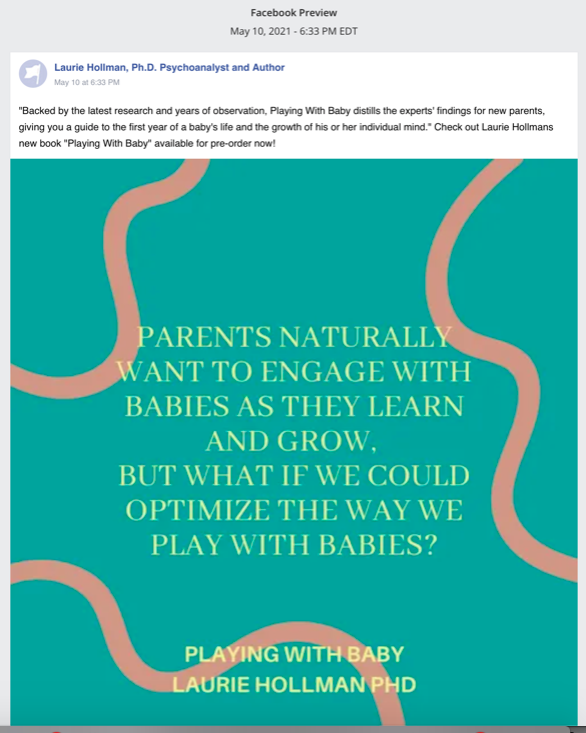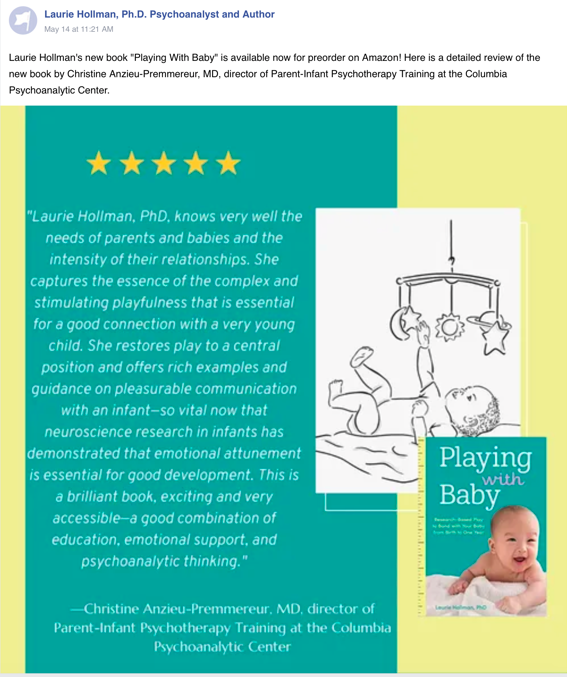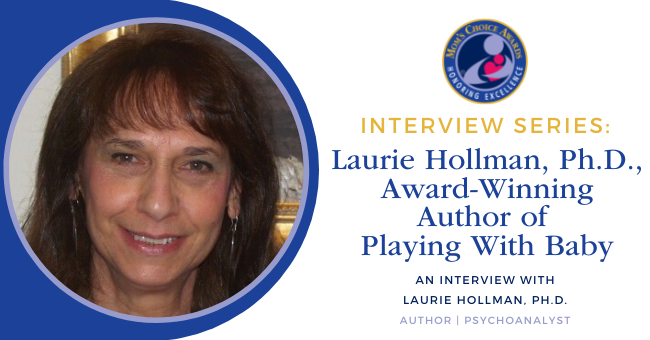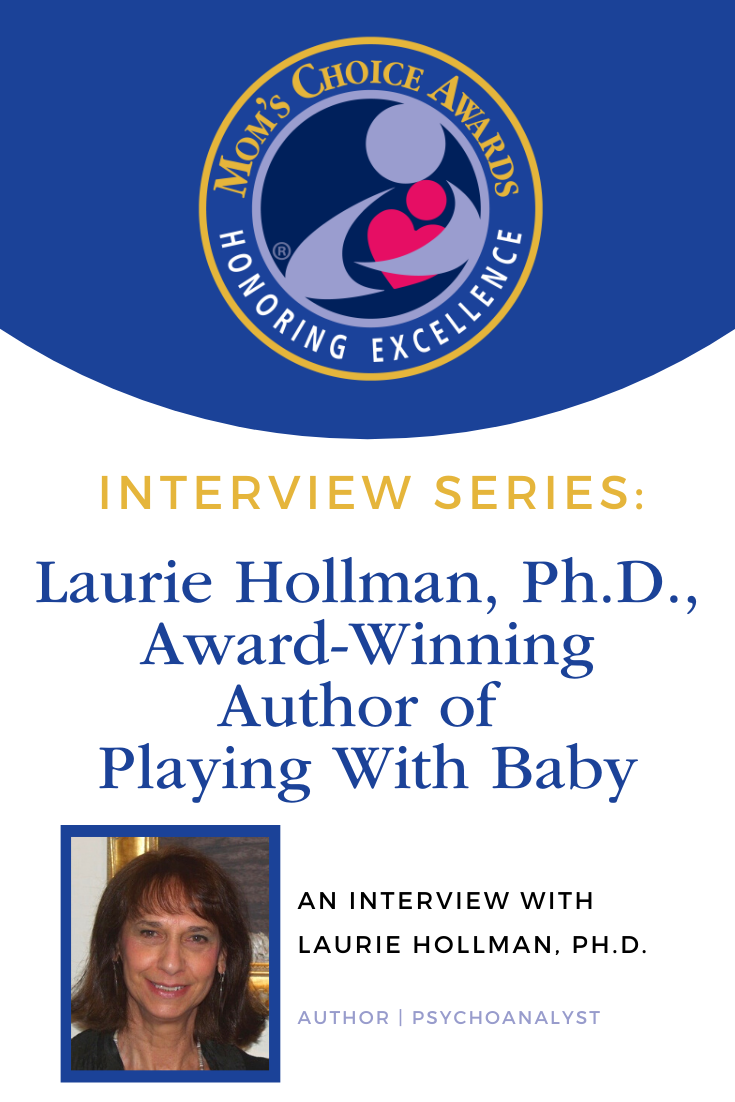Mom’s Choice Awards is excited to announce another post in our interview series where we chat with the inventors, designers, publishers, and others behind some of our favorite family-friendly products.
Hello, Mom’s Choice readers! Thank you for joining us for yet another interview in our series. For this interview, we were able to speak with Laurie Hollman, Ph.D., the author of the MCA award-winning book Playing With Baby: Research-Based Play Birth To One Year. In Playing With Baby: Research-Based Play Birth To One Year, Dr. Laurie Hollman explains to her readers the dozens of stimulating and imaginative ways infants play from birth to one year. Multiple illustrations in words and pictures are backed up by fascinating cutting-edge research about how play promotes infants’ development and a secure attachment between mother and baby. This interview is packed with crucial information and a must-read for new mommies! Keep reading to find out more about Laurie and her award-winning book, Playing With Baby: Research-Based Play Birth To One Year!
MCA: Hi Laurie, It is very nice to meet you! Thank you for sitting down with us today to talk about your new book, Playing With Baby: Research-Based Play Birth To One Year! Playing With Baby: Research-Based Play Birth To One Year is such an essential tool for all new parents to have. I’d first like to start the interview by having you tell us a little bit about yourself!

A Quote by Laurie within “Playing with Baby.”
Laurie: I am a psychoanalyst with specialized clinical training in infant-parent, child adolescent, and adult psychotherapy and an expert on the Narcissistic Personality Disorder elaborately illustrated in my book, “Are You Living with a Narcissist? How Narcissistic Men Impact Your Happiness, How to Identify Them, and How to Avoid Raising Them.”
I am an authority on modern parent-child relationships and an award-winning author who has published seven books. I have been on the faculties of New York University and the Society for Psychoanalytic Training and Research, among others.
I have written extensively on parenting for various publications, including the Psychoanalytic Study of the Child, The International Journal of Infant Observation, The Inner World of the Mother, Newsday’s Parents & Children Magazine, and Long Island Parent in New York. I blogged for Huffington Post extensively and currently contribute articles for Thrive Global, Mind Body Green, Authority Magazine, Choosing Therapy, and Upjourney. I also write for Active Family Magazine in San Francisco and am a parenting expert for Good Housekeeping and Bustle Lifestyle and other magazines.
My Gold Mom’s Choice Award-winning books are “Unlocking Parental Intelligence: Finding Meaning in Your Child’s Behavior.” My companion, award-winning books are “The Busy Parent’s Guide to Managing Anxiety in Children and Teens: The Parental Intelligence Way,” and “The Busy Parent’s Guide to Managing Anger in Children and Teens: The Parental Intelligence Way.”
Other books in this series are “The Busy Parent’s Guide to Managing Technology with Children and Teens: The Parental Intelligence Way” and “The Busy Parent’s Guide to Managing Exhaustion with Children and Teens: The Parental Intelligence Way.”
In 2021, my latest arrival is “Playing with Your Baby: Research-Based Play to Bond with Your Baby from Birth to One Year” which also received your Gold Mom’s Choice Award prior to its release.
Further information can be found in detail on my website that I welcome you to visit: https://lauriehollmanphd.com/ (more bio, more publications, details about books with excerpts and extensive endorsements and media)
My hobbies and other interests are painting- see lauriehollmanphd.com – being an active mother, mother-in-law, and grandmother (grandkids ages 20 months, 10, and 13!)
MCA: Can you tell us about your work with parents and children as a psychoanalytic psychotherapist?
Laurie: I’ve been trained to work with individuals, couples, parents, and kids of all ages beginning in infancy. My approach is always to orient parents to view their children who present puzzling behaviors as kids in distress, not “bad” or “wrong” or “acting up.”
This approach lends itself well to parents learning to understand what might be going on in their child’s mind that’s resulting in action or behavior that is a form of communication when words cannot be found. Anxiety lowers immediately with this approach and kids are seen as children and teens just trying to get something across they very much want their parents to understand and help them with.
MCA: How did you shift from your practice to writing nonfiction for parents?
Laurie: This approach worked so well in my practice that I wanted to reach more than just those parents and kids who came for treatment. Writing for the general parent populace allowed me to do so.
MCA: Tell us about your concept of the “Parental Intelligence Way”
Laurie: Some parents are invigorated by their children, some are alienated. But they all think about them, love them, and want to like them. Faced with distressed children, parents often lose their compass. They search for a path that will help them understand and get to know their children better. Quite often misbehaviors are the beacon to a child’s emotional struggles.
Parents ask, “Why does my child behave that way?” When parents understand that there are meanings behind these behaviors, underlying problems are revealed, and solutions naturally follow as parents and children grow together.
My plan is to help parents experience the heightened energy and deep satisfaction that comes with becoming meaning-makers empowered to read their child’s actions by unlocking their Parental Intelligence.
How can parents find meaning in their child’s behavior? The parent will take away a new style of parenting life that will sustain them through happy and distressing times with their children through all stages of child development. Parents will be able to understand what’s happening in their child’s minds. The key lies in the Five Steps to Parental Intelligence which looks at the parent’s and child’s unconscious mind when solving problems.
Parental Intelligence is a concept I created when working with parents in my private practice who learned how to “read” non-verbal as well as verbal communication and enjoy open dialogue. The steps are a guide for the parent who faces baffling behaviors and hard-to-reach children, including those with special needs.
Parents should never be underestimated even when they doubt themselves. Learning how to harness the knowledge they have about their child by following the five steps reviewed below leads them to unlock their Parental Intelligence and find resolutions to their children’s problems.
- Stepping back helps a parent to review what has happened.
- Self-reflecting encourages parents to revisit the ghosts from the past that influence their own reactions.
- Understanding your child’s mind opens windows onto the child’s world with their own particular point of view.
- Understanding your child’s development clarifies what to expect cognitively and socially from your individual child.
- Finally, problem-solving will lead to long-lasting solutions to the pressing problems that seem, at first, to have no possible resolution.
Experience compassionate stories of mothers and fathers using Parental Intelligence that reveal how they resolve problems with their children in my book “Unlocking Parental Intelligence: Finding Meaning in Your Child’s Behavior.”
Examples range from infants to toddlers, from tweens to adolescents, from the typical–if there is such a thing–to those with special needs.
Included are stories about:
- a baby’s first six months
- an adopted child’s first two years
- a four-year-old with high functioning Asperger’s
- a six-year-old identical twin
- an eight-year-old with ADHD
- an outgoing thirteen-year-old
- a depressed fifteen-year-old
- and a brilliant seventeen-year-old.
You will meet a stay-at-home father, a single-parenting mother, couples whose marriages are holding on by a thread, and intact families that cross the boundaries of economic levels, social class, and education. Half the stories focus on the father as the pivotal character.
All the while, learn about contemporary research on the intrauterine environment, the “new wave of scheduled socialization,” “the new adolescent autonomy,” autistic communication, fatherhood and more. The similarities and differences between how mothers and fathers carry out the Five Steps to Parental Intelligence are explored. The once often overlooked parent, the father, is fully revealed with respect to his importance as a sensitive, responsive, nurturing parent for newborns, children, and adolescents.
Finally, imagine the future where Parental Intelligence is the norm, not only on the family, but on society as well.
MCA: How did your training, research experience, and practice as an infant-parent psychotherapist lead to writing Playing with Baby?

A Review of “Playing with Baby.”
Laurie: A baby hears her mother’s voice in utero, claps her hands a few months later, plays peekaboo over and over and follows a finger pointed at her toy. What does it all mean?
In this book, I wend my way through dozens of stimulating and imaginative ways infants play from birth to one year. Multiple illustrations in words and pictures are backed up by fascinating cutting-edge research about how play promotes infants’ development and a secure attachment between mother and baby.
Specific training as an Infant-Parent Psychotherapist led me to spend decades of hours with mothers, fathers, and babies who inspired me to write this book.
Playing with an infant month by month the first year may or may not come naturally to some parents. These parents who do not have experience playing with newborns month by month find it challenging and exciting but seek guidance. These parents may not have received nurturing themselves throughout childhood and so they want to get the knack of playing by talking to me about their baby’s development month by month while also joining me on the floor playing. As they observe me play with their babies, they learn first by watching then by playing on their own. It’s wonderful to see.
Even experienced parents who play rather easily are so inundated by a broad range of play activities that they are immensely grateful to discover which activities promote development each month.
Remarkable experiences with babies have led me to want to write this book with numerous illustrations of my actual play with parents and their infants that is based on cutting edge research I was privileged to observe in the making. The choice of play activities described endlessly in this book are based on this research done by world renown psychologists and psychiatrists whose careers focused on the infant’s inner and outer worlds.
The infants’ worlds that I admire are the inspiring development of their minds as well as their daunting physical prowess. For example, from the start newborns recognize their mother’s voice and begin to interact with her sounds and movements.
It’s a great joy for me to share my own continuing astonishment at the workings of a baby’s mind with parents in my therapy room and now in this book.
A brief example I enjoy reveling in with parents is how after several months their baby points to objects and people. Why is this so exciting? Because the baby is demonstrating her motor development along with her brain development.
How? Her pointing says through action what she intends. Yes. Babies already have clear and specific intentions that motivate their actions. When mothers respond by picking up an object being pointed to, all without words mind you, the baby feels understood and shows delight with a giggle or smile.
So, what’s so amazing? The mother and baby are having a conversation before words. Then the mother can point at something and the baby follows the line of her pointing with his eyes showing he knows that his mother has a mind separate from his. How? Well, he sees the mother has her own specific intentions, just like he does. Parents of all ages, from adolescent mothers to mothers in their twenties, thirties, forties, and less often, but possibly, in their fifties feel how important playing with their infants becomes as they learn how to change their play choices month by month.
Play is the vehicle for babies to learn and interact with their mothers and fathers forming secure attachments. An infant’s feeling of security is what allows them to trust and learn from others.
Helping mothers and fathers develop secure attachments in infancy through play at four months, for example, leads to secure attachments at one year and beyond.
This is the marvelous understanding research reveals. And by writing all this down in one book – infant development – infant play – infant and parent social interactions – empathic journeys with babies – I have felt a tremendous sense of pleasure and satisfaction.
MCA: Can you give us a few specific research findings about infant development that have been highlighted in Playing with Baby and how these findings help engage parents in the most pleasurable and exciting forms of play with their baby?

A Review of “Playing with Baby.”
Laurie: Newborns are mysterious and fascinating little beings. As parents, we wonder, “What’s going on in that tiny head of yours?” Let’s look at some fantastic findings.
As you will see, babies are looking to interact and engage from the beginning. Yes! From the absolute beginning! At birth, they can differentiate human faces and voices from other sights and sounds—and they prefer them.
From birth, your wonderful infant will be attuned especially to the mother’s voice heard in utero. The baby will select the Mommy voice over all others to attend to. That is, your baby minutes after birth already is capable of separating out his specific mother’s already familiar voice that gives him security.
Remarkably, a baby’s line of sight or vision is most clearly focused at the distance of a person holding them. It’s as if they are designed to see the people who love them more clearly than anything else.
Babies love novelty. If they see the same picture over and over, they lose interest. Show them something else, and they perk right up! In the first instance, they have habituated to the image. That is, with repeated exposure they have become less responsive. But the unfamiliar image is a novel focus—they are curious about something new.
Babies recognize noises. As a newborn, if a baby hears a noise, he will look in that direction, suggesting he already expects to see something to which the noise directed him. In other words, babies connect sound and vision. By five months old, their minds are even more complex, discriminating between what sound goes with what object or face. Then by the time they are nine months old, they have discovered that something hasn’t disappeared when it’s been covered or hidden from view. They discover this through repetition. What a fun year of progression you have ahead of you!
Babies do what they see! They are attuned to people and are active imitators early on. Stick out your tongue at a baby and she will stick out her tongue at you. Similarly, open your mouth and your infant will open hers. This is at one month old! How fast babies learn from us.
In order to imitate, newborn babies must somehow understand the similarity between an internal feeling and the external face they see, like a round shape with a long pink thing at the bottom moving back and forth [the tongue].
Further, babies seem to know things have three dimensions. They know that something that looks curved also feels curved!
Do you know that newborns distinguish and even prefer faces? They recognize faces are like their own. That is, they recognize other people are ‘like me.” From the time they are born they seem to be in touch with their movements, aches, and tickles. This is a very early recognition of their personal self. From birth, they also sense somehow that their bodily movements of that growing personal self are like yours. So, they notice movements of yours they can see yet not feel.
While we know that babies love human voices and faces, they also, astonishingly, show interest in stripes and edges. You can show your babies different pictures and notice where they look. Babies turn toward complex patterns such as stripes with high contrast—not simple patterns with little contrast. For example, they love checkerboards and bull’s-eyes. Babies also notice the differences between the brightness and texture of two surfaces and where objects begin and end. So, they can identify edges, allowing them to separate different objects (65).
MCA: If you could ensure readers of your book walk away with one main lesson, what would it be?
Laurie: Enjoy optimizing play activities based on research findings that enhance your relationship with your baby hour by hour, day by day, month by month to ensure the wonder of a secure attachment or bond with your infant.
MCA: This has been such an informative interview, thank you so much for sharing! We look forward to hearing more from you in the near future.
You can learn more about Laurie Hollman, Ph.D., and her award-winning book, Playing With Baby: Research-Based Play Birth To One Year by visiting her MCA Shop pages.






